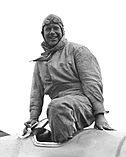Flying Ace 1939-1945 Of Power Nazi Negativity towards USSR
Flying Ace History
A fighter ace or air ace is a military aviator credited with shooting down five or more enemy aircraft during aerial combat. The exact number of aerial victories required to officially qualify as an ace is varied but is usually considered to be five or more.
The concept of the “ace” emerged in 1915 during World War I, at the same time as aerial dogfighting. It was a propaganda term intended to provide the home front with a cult of the hero in what was otherwise a war of attrition. The individual actions of aces were widely reported and the image was disseminated of the ace as a chivalrous knights reminiscent of a bygone era.[1] For a brief early period when air-to-air combat was just being invented, the exceptionally skilled pilot could shape the battle in the skies.
The successes of such German ace pilots as Max Immelmann and Oswald Boelcke, and especially Manfred von Richthofen, the most victorious fighter pilot of the First World War, were well-publicized for the benefit of civilian morale, and the Pour le Mérite, Prussia’s highest award for gallantry, became part of the uniform of a leading German ace. In the Luftstreitkräfte, the Pour le Mérite was nicknamed Der blaue Max/The Blue Max, after Max Immelmann, who was the first pilot to receive this award.
The successes of such German ace pilots as Max Immelmann and Oswald Boelcke, and especially Manfred von Richthofen, the most victorious fighter pilot of the First World War, were well-publicized for the benefit of civilian morale, and the Pour le Mérite, Prussia’s highest award for gallantry, became part of the uniform of a leading German ace. In the Luftstreitkräfte, the Pour le Mérite was nicknamed Der blaue Max/The Blue Max, after Max Immelmann, who was the first pilot to receive this award. Initially, German aviators had to destroy eight Allied aircraft to receive this medal.[3] As the war progressed, the qualifications for Pour le Mérite were raised,[3] but successful German fighter pilots continued to be hailed as national heroes for the remainder of the war. Flying ace in.
Flying Ace
The successes of such German ace pilots as Max Immelmann and Oswald Boelcke, and especially Manfred von Richthofen, the most victorious fighter pilot of the First World War, were well-publicized for the benefit of civilian morale, and the Pour le Mérite, Prussia’s highest award for gallantry, became part of the uniform of a leading German ace. In the Luftstreitkräfte, the Pour le Mérite was nicknamed Der blaue Max/
The successes of such German ace pilots as Max Immelmann and Oswald Boelcke, and especially Manfred von Richthofen, the most victorious fighter pilot of the First World War, were well-publicized for the benefit of civilian morale, and the Pour le Mérite, Prussia’s highest award for gallantry, became part of the uniform of a leading German Flying ace
ace. In the Flying Ace
World War I flying ace

Initially, German aviators had to destroy eight Allied aircraft to receive this medal.[3] As the war progressed, the qualifications for Pour le Mérite were raised,[3] but successful German fighter pilots continued to be hailed as national heroes for the remainder of the war.
The Blue Max, after Max Immelmann, who was the first pilot to receive this award. Initially, German aviators had to destroy eight Allied aircraft to receive this medal.[3] As the war progressed, the qualifications for Pour le Mérite were raised,[3] but successful German fighter pilots continued to be hailed as national heroes for the remainder of the war Flying ace

